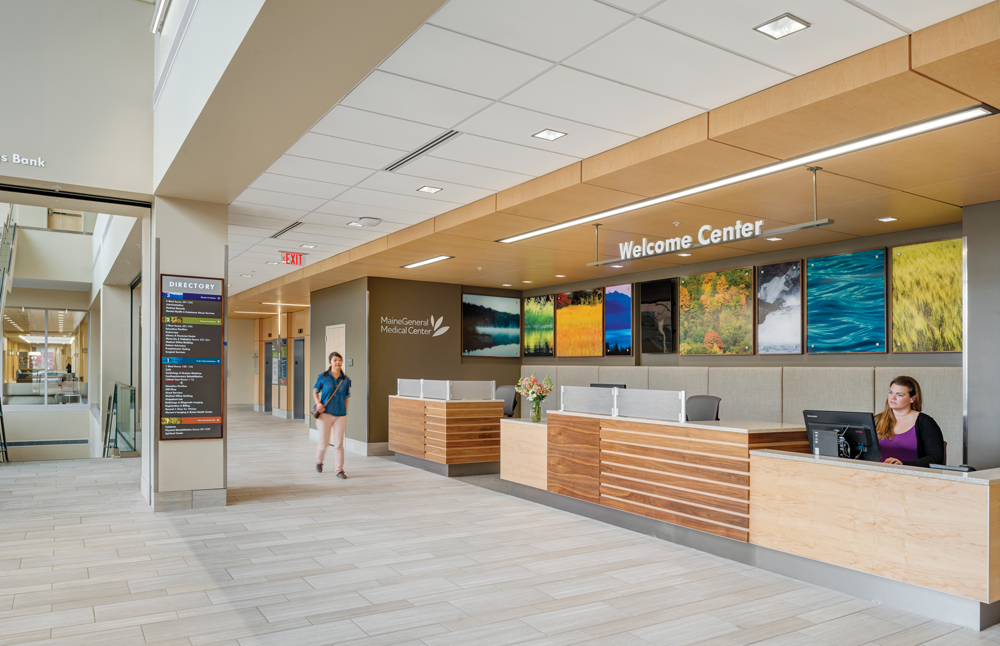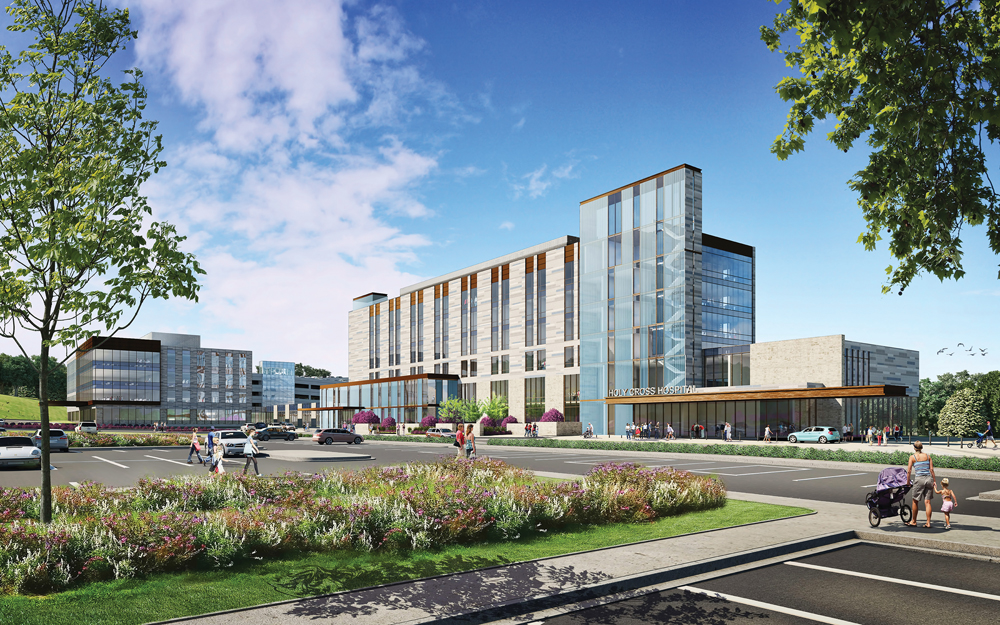Editor's note: This article was originally published as part of BD+C's two-part March 2014 Healthcare Facilities Report. Read the first installment of the report, "How your firm can win more healthcare projects."
For BD+C's March 2014 Healthcare Facilities Report, we interviewed seven healthcare planning and design experts from major healthcare organizations, including Sutter Health, Ascension Health, and CHE Trinity Health. They cited the following factors that Building Teams need to keep in mind on their healthcare projects:
1. CONSOLIDATION OF HEALTHCARE FACILITIES
A large organization like Ascension can find savings through an examination of its national property portfolio. “We have to look at each region,” says Ascension SVP Bob McCoole. “Does it have 10 half-full physician’s offices? We have to look at all opportunities to consolidate and manage space more efficiently.”
In some cases, the result of facilities consolidation isn’t to reduce the overall system footprint, but to expand it. MaineGeneral replaced two existing hospitals, totaling about 400,000 sf, with the new 640,000 sf Alfond Center for Health. The new institution holds 192 inpatient beds, a reduction from the 225 beds that the two old hospitals held. Much of Alfond’s non-inpatient space is taken up by outpatient services, and the entire Thayer facility (one of the two old hospitals) is being converted to outpatient services. So, this consolidation of inpatient capacity enabled a big jump in outpatient service capacity.
2. EFFICIENCY AND STANDARDIZATION
Much of a healthcare property executive’s time is spent on finding better, more efficient designs and rolling them out systemwide in the form of standards. In recent years, CHE Trinity had been focused on standards such as cost-per-bed based on market norms. “We’re moving toward developing norms for department and key room sizes that are based on group wisdom, with input from outside firms as well as in-house personnel,” says CHE Trinity Health’s Young.
In some cases, a small, dedicated staff of passionate hospital staffers has led the push for new standards to improve efficiency. Froedtert staff has gone through a concerted effort to analyze process flow using mapping and simulation tools. These exercises are essential to guide design, says Balzer. “You want visioning and modeling to inform design, rather than have them happen simultaneously,” he says. “If you bring in architects too early in the process, you will have a hard time stopping them from sketching drawings before you are finished gathering input.”
Sutter is a leader among major healthcare systems in adopting Lean design principles for construction and clinical practices. This had led to an innovative use of technology, with several sites using or testing kiosk patient registration. “They are similar to what you see at airports,” says Sutter Health’s Conwell. “You swipe your Sutter card or a credit card and the monitor tells you to go to a particular exam room.” This reduces waiting times for patients—a metric many healthcare systems are trying to improve.

Reception desk at the 640,000-sf MaineGeneral Medical Center, which consolidated two campuses that were 20 miles apart. Facilities include a 16-room interventional suite, a 27-bed ED, a 25-room imaging center, a cardiac gym, a conference center, and a two-story medical office building. Photo: © Anton Grassl/Esto
3. SPACE FLEXIBILITY
Facing formidable unknowns associated with implementing the Affordable Care Act, hospital designers have to bake in flexibility. Reducing walls and barriers so clinical areas can easily be reconfigured is a common tactic—a particularly important one as medical professionals learn to work more collaboratively. “We don’t want to do anything that precludes people from working together,” says Sutter Health’s Scheuerman. Sutter has also made exam rooms specialty-agnostic by providing mobile equipment carts that make any exam room capable of serving multiple specialties.
Spaces that can pull double duty can be valuable. One recent CHE Trinity project included six flex rooms on inpatient floors, to be used initially as rehab space. Should demand require it, these rooms can be easily converted to inpatient use.
Infrastructure planning is another area where providing flexibility is paramount. “We don’t want infrastructure to become dated, but we also don’t want to burden our locations with investments they don’t need,” says Froedtert’s Balzer. “If we think we might need an MRI at a location in a few years, we might upsize the electrical feeder into the building now, which can be done at relatively low cost, and up the distribution, if necessary, later.”
4. IMPROVING PATIENT OUTCOMES
With the ACA pushing hospitals hard to produce better patient outcomes, using both a carrot (financial incentives) and a stick (penalties), healthcare Building Teams need to be actively involved in research initiatives that could reduce infections, speed recovery periods, and improve medical staff performance.
Froedtert was one of the first participants in the Center for Health Design’s Pebble Project (www.healthdesign.org/pebble), an effort to compile and distribute research related to quality of care and building design. “For anything we design, we refer to the Pebble database and see what research is out there,” says Balzer.
MaineGeneral’s Alfond project was designed with evidence-based research in mind. When considering the use of generous fenestration, for instance, research on the benefits of daylight was factored in. “If it improves staff satisfaction and patient recovery, plentiful daylighting can be worth the extra expense,” says Stein. MaineGeneral also installed a pneumatic tube system to transport lab specimens to the central lab, instead of having staff wheel the samples around on carts. The reduced turnaround on test results has improved quality of care along with staff efficiency.

CHE Trinity Health’s 237,000-sf Holy Cross Germantown Hospital will provide medical/surgical, obstetrics, and psychiatric services on the campus of Montgomery College when completed later this year. The facility, the first new hospital in Montgomery County, Md., in more than 30 years, will include 98 patient rooms, five ORs, 14 emergency beds, five labor rooms, an eight-bassinet neonatal unit, and an on-site medical office facility. Building Team: SmithGroupJJR (architect, medical planner, programming, interiors, lighting, landscape architecture), Leach Wallace/Syska Hennessy (MEP), McMullan & Associates (SE), CBRE (owner’s rep), and Whiting-Turner (CM). KLMK (now CBRE Health) served as owner’s project manager. Photo: courtesy SmithGroupJJR and CHE Trinity Health
5. COST-CUTTING AND IMPROVED EFFICIENCY BY DESIGN
Hospital systems are breaking the design mold to cut costs. In the past, every major medical discipline had its own reception area. No more. Now, as many as four different disciplines may share a single reception space.
Healthcare providers are also struggling with how elaborately appointed their facilities have to be to attract patients. Finding the right balance between spending enough on attractive furnishings and finishes to be competitive, versus overspending on ornamentation, is a constant dilemma.
If Ascension’s McCoole had his way, the whole industry would take a pill and slow down a bit on accoutrements. He points to the use of precast concrete in the construction of the recently completed St. Vincent’s HealthCare facility in Jacksonville, Fla. No fancy twisted elevations here: the building’s corners were kept at an economical 90 degrees. “It won’t win any design awards,” says McCoole. “We included nice lobbies with terrazzo floors, but that’s the extent of the ornamentation.”
CHE Trinity’s new strategy of employing commissioning agents early in the design process is already a proven money-saver, says Young. Commissioning experts found that plans for the central plant of a new hospital had improperly routed the piping. A redesign yielded a much smaller central plant. and the energy savings will total millions of dollars over the lifespan of the facility, Young says.
Life cycle analysis to evaluate sustainable elements in hospital projects is a calculus that is constantly in flux. For example, Froedtert recently mandated LED lighting as the standard on new construction and major renovations as LED prices continue to drop.
6. BIM, IPD, AND PREFABRICATION
Healthcare organizations increasingly demand some flavor of integrated project delivery—formal or otherwise—on major projects. “We’re using it in spirit, but not in contracts,” says Balzer. All of our experts told us that collaboration among Building Team member firms is a must.
The major Building Team players should also be BIM-savvy. Healthcare organizations are increasingly looking to use BIM throughout a building’s life cycle. “Our maintenance staff is instrumental in driving our standards and how we leverage BIM,” says Froedtert’s Balzer.
Prefabrication of parts and units is also becoming a more frequently used tool. CHE Trinity uses off-site prefab for above-ceiling utilities, and sometimes on bathrooms. The central plant on a new 80-bed hospital currently under design will be prefabricated—a first for CHE Trinity, says Young.
“Prefab is near and dear to my heart,” says Froedtert’s Balzer. “We’re looking at the feasibility of offsite construction of exam rooms for a Advanced Care Center. Five years from now, we expect to be using prefab more heavily."
Read the first installment of BD+C's March 2014 Healthcare Facilities Report, "How your firm can win more healthcare projects."
Related Stories
Office Buildings | Apr 2, 2024
SOM designs pleated façade for Star River Headquarters for optimal daylighting and views
In Guangzhou, China, Skidmore, Owings & Merrill (SOM) has designed the recently completed Star River Headquarters to minimize embodied carbon, reduce energy consumption, and create a healthy work environment. The 48-story tower is located in the business district on Guangzhou’s Pazhou Island.
K-12 Schools | Apr 1, 2024
High school includes YMCA to share facilities and connect with the broader community
In Omaha, Neb., a public high school and a YMCA come together in one facility, connecting the school with the broader community. The 285,000-sf Westview High School, programmed and designed by the team of Perkins&Will and architect of record BCDM Architects, has its own athletic facilities but shares a pool, weight room, and more with the 30,000-sf YMCA.
Market Data | Apr 1, 2024
Nonresidential construction spending dips 1.0% in February, reaches $1.179 trillion
National nonresidential construction spending declined 1.0% in February, according to an Associated Builders and Contractors analysis of data published today by the U.S. Census Bureau. On a seasonally adjusted annualized basis, nonresidential spending totaled $1.179 trillion.
Affordable Housing | Apr 1, 2024
Biden Administration considers ways to influence local housing regulations
The Biden Administration is considering how to spur more affordable housing construction with strategies to influence reform of local housing regulations.
Affordable Housing | Apr 1, 2024
Chicago voters nix ‘mansion tax’ to fund efforts to reduce homelessness
Chicago voters in March rejected a proposed “mansion tax” that would have funded efforts to reduce homelessness in the city.
Standards | Apr 1, 2024
New technical bulletin covers window opening control devices
A new technical bulletin clarifies the definition of a window opening control device (WOCD) to promote greater understanding of the role of WOCDs and provide an understanding of a WOCD’s function.
Adaptive Reuse | Mar 30, 2024
Hotel vs. office: Different challenges in commercial to residential conversions
In the midst of a national housing shortage, developers are examining the viability of commercial to residential conversions as a solution to both problems.
Sustainability | Mar 29, 2024
Demystifying carbon offsets vs direct reductions
Chris Forney, Principal, Brightworks Sustainability, and Rob Atkinson, Senior Project Manager, IA Interior Architects, share the misconceptions about carbon offsets and identify opportunities for realizing a carbon-neutral building portfolio.
Reconstruction & Renovation | Mar 28, 2024
Longwood Gardens reimagines its horticulture experience with 17-acre conservatory
Longwood Gardens announced this week that Longwood Reimagined: A New Garden Experience, the most ambitious revitalization in a century of America’s greatest center for horticultural display, will open to the public on November 22, 2024.
Office Buildings | Mar 27, 2024
A new Singapore office campus inaugurates the Jurong Innovation District, a business park located in a tropical rainforest
Surbana Jurong, an urban, infrastructure and managed services consulting firm, recently opened its new headquarters in Singapore. Surbana Jurong Campus inaugurates the Jurong Innovation District, a business park set in a tropical rainforest.

















